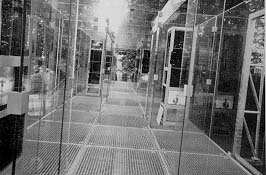| In the third example, Tschumi provides images of a glass video gallery that uses rigid structure but, simultaneously, questions that structure, uses it against itself: walls that are not walls but are invisible. More shocking is the prospect of moving through this space--the grid would seem to be completely predictable and logical, the height of cartesian thought. But because the walls themselve are visually permeable but not physically permeable, entering into the different spaces of the gallery requires us to constantly renegotiate our path. A more famous example here--one which many of you are probably familar through first-hand experience or the analyses in works by theorists such as Edward Soja or Frederic Jameson--is Portman's LA Bonaventure, which includes a series of balconies overlooking a mall; the spaces constructed by the balconies and drops are so complex that inhabitants cannot easily find their way from point A to point B, but instead must constantly remap their positions and try new routes to get where they're going. |
|
This sort of destructuring is actually one that many of us will be the most familiar with, since it grows pretty directly out of Derrida's work. Hypertext, especially postmodern hypertexts such as Moulthrop's Victory Garden Guyer and Petry's Izme Pass do a very good job at interrogating textual structure, although I'm not sure we tend to continue this work in our classes--we should. And if such works seem a little too "postmodern" to be teaching our students, because we are worried that students can't write like that in the "real world". But before we make that assumption, we should remember that the architectural works we're looking at here are real-world (and in fact, the architects involved make quite a bit more money than all of us do; and money, after all, is what the real world's apparently all about, or at least that's what I'm told).
 Glass Video Gallery (from Tschumi, Architecture & Disjunction)
Glass Video Gallery (from Tschumi, Architecture & Disjunction)